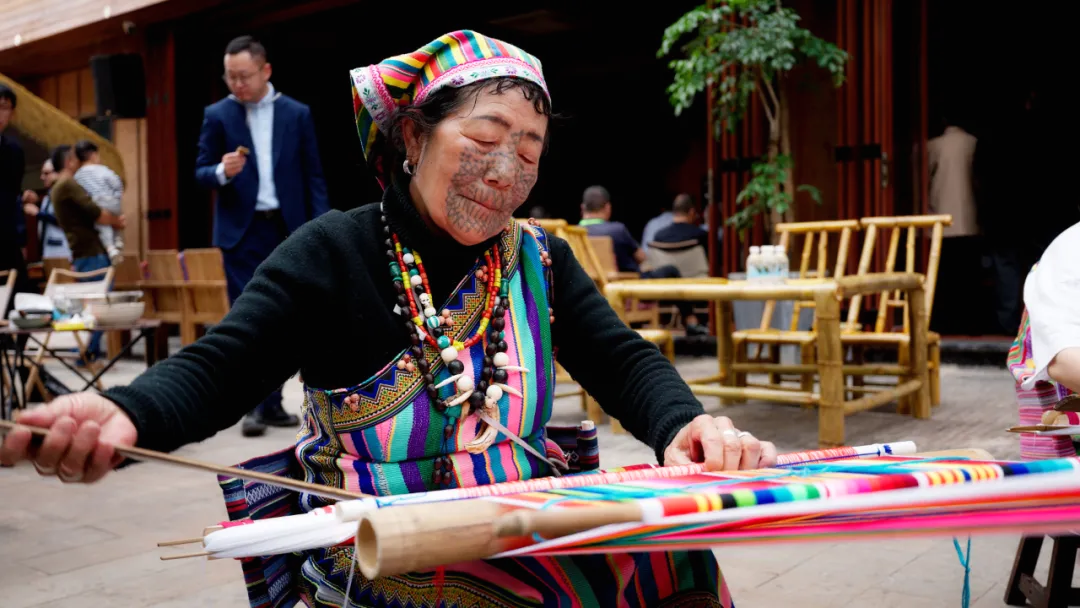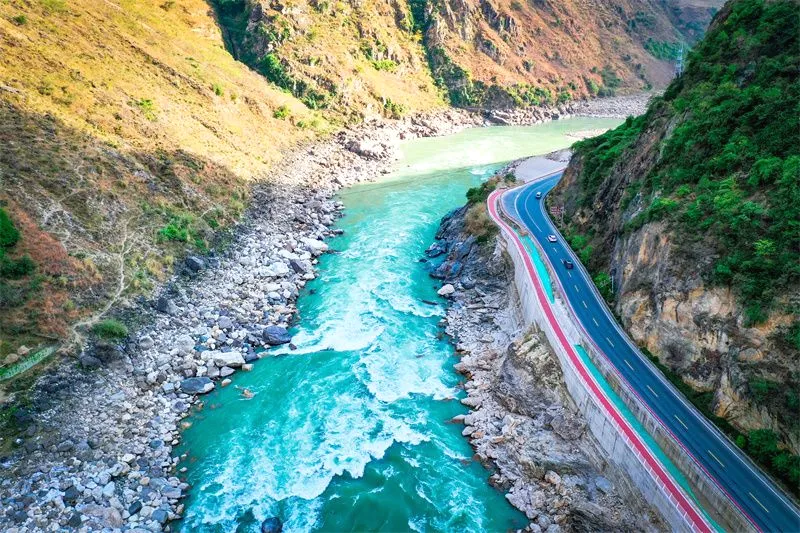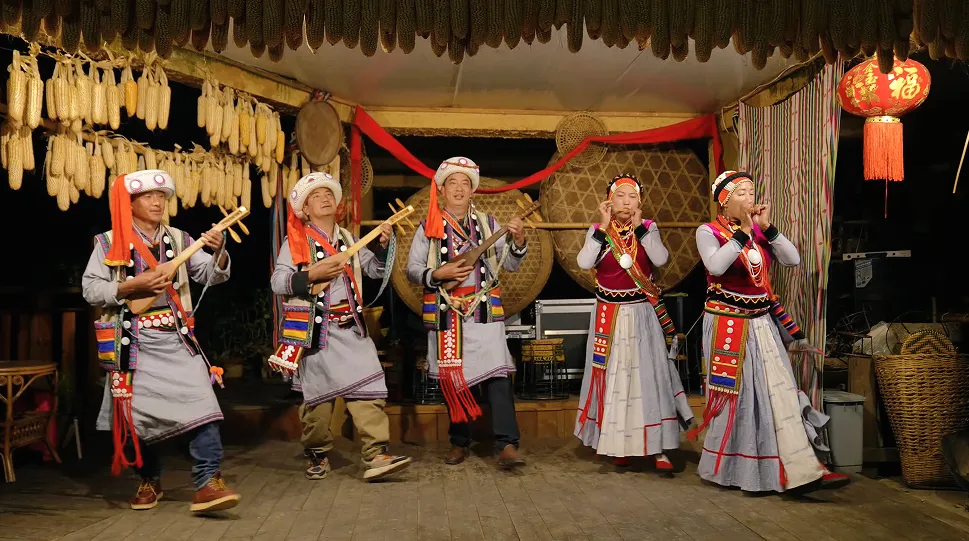The canyon’s call: Harmony between nature and culture
On March 29, 2025, the International Forum on Poverty Governance and Global Development commenced in Lushui City, Nujiang Lisu Autonomous Prefecture. Once isolated within a deep canyon, this region is now showcasing a vibrant model of “ecological poverty alleviation.” Through tourism, this formerly remote area is transforming its stunning scenery and rich ethnic cultures into a driving force for rural revitalization.
As participants at the forum consider a sustainable future, the surging Nujiang River connects the canyon’s treasures: its hidden landscapes, intangible heritage, ecological wonders, and vibrant ethnic traditions—a tapestry worthy of World Heritage recognition. In this issue, we invite you to explore the depths of the Nujiang Grand Canyon, step into the core of the “Three Parallel Rivers” World Heritage Site, and discover the captivating harmony between nature and culture.

A rare bird is seen in the Nujiang Grand Canyon.
A canyon of natural wonders
Nujiang Lisu Autonomous Prefecture, cradled between the Qinghai-Xizang and Yunnan-Guizhou Plateaus, boasts one of Earth’s youngest canyon systems. This 300+ kilometer canyon, sculpted by the Hengduan Mountains, is both a geological record and a haven for life. From the Nujiang Grand Canyon’s dramatic cliffs to Gaoligong Mountain’s rich biodiversity, the land narrates a grand story of nature.
The Nujiang Grand Canyon’s vertical landscape is breathtaking. Biluo Snow Mountain and Gaoligong Mountain, flanking the canyon, rise over 4,000 meters, contrasting sharply with the Nujiang River at 700 meters. This 3,300-meter drop creates the phenomenon of “One mountain holds all seasons, and every turn reveals a new sky.” The powerful river, forced into the “c” near Bingzhongluo Town, forms a near-300-degree curve. Kantong Village, nestled within this bend, becomes a springtime haven of peach blossoms, a jewel within the canyon.
As a central component of the “Three Parallel Rivers” World Natural Heritage Site, the Nujiang region showcases an extraordinary geological phenomenon. Here, the Nujiang, Lancang (Mekong), and Jinsha Rivers run parallel through northwestern Yunnan, separated by as little as 66 kilometers, but never converging thanks to the mountainous terrain. This creates a singular microclimate zone, where seven distinct natural zones are vertically stacked, from subtropical rainforests at the canyon’s base to alpine meadows near the snow line. This remarkable biodiversity has earned the region the nickname “Noah’s Ark of the plant kingdom.”
Gaoligong Mountain represents the crescendo of this ecological marvel. As China’s largest remaining virgin forest, it safeguards an astounding array of life, with over 5,000 identified higher plant species, including ancient survivors like Alsophila spinulosa and yew trees. Zoologists recognize it as a crucial area for the diversification of mammals. Here, the rare Nujiang golden snub-nosed monkey, numbering only around 300 individuals, exhibits fur like molten gold in the sunlight. Clouded leopards and black bears roam the deep woods, while glimpses of the iridescent green peafowl shimmer in the early morning mist.
The Nujiang River’s ecological significance is powerfully illustrated by its bird diversity. Gaoligong Mountain ranks among China’s most biodiverse regions for birds; of the 749 species identified there, 525 reside within the Nujiang area. This represents an extraordinary proportion—over one-third of all bird species found in China, and more than half of those found in Yunnan. From October to May, Nujiang Prefecture becomes a haven for millions of migratory birds fleeing harsh conditions and seeking sustenance, making the Nujiang River a vital staging ground in their epic journeys.
To leverage its rich birdlife, Nujiang Prefecture has established 50 birdwatching sites across its four counties: 29 in Lushui City, 14 in Fugong County, 5 in Gongshan County, and 2 in Lanping County. The Nujiang Hundred Birds Valley Scenic Area, near the Gaoligong Mountain Nature Reserve in Lushui City, is a prime example. It provides habitat for over 200 species of China’s first and second-class protected birds and features 20 “birdwatching ponds,” making it a haven for photographers and bird enthusiasts alike.

A Lisu woman weaves at home in the Nujiang Grand Canyon.
A valley of diverse cultures
Nujiang Prefecture is more than a geographical canyon; it is a deep valley of diverse ethnic cultures. For millennia, ethnic groups like the Lisu, Nu, and Dulong have thrived here, weaving a rich cultural tapestry of songs, festivals, crafts, and beliefs. Their cultural heritage, passed down through generations and adapted for modern audiences, retains its authenticity while embracing the future.
Nujiang is a land where the cultures of the Lisu, Bai, Dulong, Pumi, Jingpo, Yi, and other groups blend seamlessly, their lives punctuated by year-round festivals, dances, and songs. Central to the Lisu people is the Kuoshi Festival, their vibrant celebration of the New Year (equivalent to the Spring Festival). “Kuoshi,” in the Lisu language, signifies “New Year.” As Kuoshi approaches, the villages come alive. The sounds of slaughtering pigs and sheep fill the air, mingled with the aroma of brewing grain liquor. Pine branches are scattered in courtyards, and families busily prepare corn cakes, slaughter pigs, and perform rituals to usher out the old and welcome the new, all while praying for favorable weather and plentiful harvests.
The Knife Ladder Festival is a significant celebration for the Lisu people. Lisu warriors demonstrate remarkable feats, including “climbing the knife ladder” and “descending into the sea of fire.” Climbing the knife ladder involves ascending a ladder over 10 meters high, its rungs replaced with sharp, gleaming blades. The warriors, treading barefoot as if on solid ground, embody the Lisu people’s bravery and fearlessness. Descending into the sea of fire showcases warriors jumping into burning charcoal piles, rolling on the embers, and rubbing burning coals on their faces, a ritual symbolizing resilience against future misfortune.
The Kaquewa Festival marks the New Year for the Dulong ethnic group in Nujiang, and it is their sole festival of the year. To celebrate, each household displays prayer flags, burns pine branches, and plays gongs and drums. As night falls, families prepare a lavish meal and gather with loved ones to toast to a prosperous harvest in the year ahead. The “Bull Sacrifice to Heaven” ceremony is a central part of the festival. A respected village elder chooses a strong bull, which is then adorned with a Dulong blanket and colorful beads. The community dances around the bull before young men, wearing Dulong blankets and carrying spears, perform a ritual spearing of the animal. Afterwards, the beef is cooked and shared among the villagers, who sing and drink together, praying for healthy livestock and a bountiful harvest.
Beyond festivals, the people of Nujiang Prefecture preserve their history through intangible cultural heritage, including ethnic dances. The “Dabiya Dance” of the Nu ethnic group is a prime example. Named after the “Dabiya,” the Nu people’s oldest plucked instrument, this dance was recognized in 2014 as part of China’s national intangible cultural heritage. Dancers play the “Dabiya” while dancing, using music and movement to depict various aspects of Nu life and work.
Dulong blankets are more than just textiles; they are a unique cultural emblem of the Dulong ethnic group in Nujiang. Woven with hemp thread and vibrant, plant-based dyes, each blanket takes over a month to complete, earning the description “a wearable epic.” Today, Dulong women are innovatively blending traditional techniques with modern designs, creating a range of cultural products alongside blankets. These items are now sold in countries like the United Kingdom and the Netherlands, allowing the ancient art of Dulong blanket making to flourish in the modern world.

A view the Nujiang Grand Canyon
A dream destination of outdoor adventure
Nujiang’s diverse terrain offers an unparalleled playground for outdoor enthusiasts. Mountaineering, hiking, cycling, and whitewater kayaking are just a few of the activities that make Nujiang a dream destination—an “outdoor activity paradise” for those seeking adventure and a connection with the unknown.
The spirit of outdoor adventure is woven into the very fabric of Nujiang, a legacy born from its dramatic geography. Each November, the International Wildwater Canoeing Open on the Nujiang River transforms the river valley into a world-class stage, drawing over a hundred athletes from more than ten countries. They come to test their speed and courage against the formidable currents of the Nujiang River. The Laohutiao section, a particularly challenging 350-meter stretch characterized by towering cliffs and treacherous rock formations, is especially lauded by competitors. As Spanish competitor L. L.·David noted, “The natural advantages create a natural arena, giving me a different competitive state.”
National Highway 219’s Nujiang section, known as the “Nujiang Beautiful Highway,” has dramatically improved access to the region for both drivers and cyclists. This nearly 300-kilometer stretch from Lushui to Bingzhongluo, opened in January 2020, has cut travel time from a full day to just five or six hours. Cyclists benefit from approximately 200 kilometers of dedicated greenway running parallel to the highway, ensuring a safe and enjoyable ride. The remaining 100 kilometers require cyclists to share the highway.
Nujiang’s spring and autumn seasons beckon hikers to explore its diverse trails. The classic “First Bend of Nujiang River Hiking Route,” a 19.5-kilometer loop from Bingzhongluo Township, unveils iconic views from the Bingzhongluo Viewing Platform and the famed First Bend. For deeper immersion, the “Luoguqing Forest Hiking Route” in Lanping County winds through mountains, forests, and streams, beginning at Qingrenba and ending at Qinghuadian Wetland Park. Alternatively, the popular “Bingzhongluo-Qiunatong Hiking Route” (17-18 kilometers) blends stunning Nujiang River scenery with cultural encounters, passing Chongding Church, Shimen Pass, the Ancient Tea Horse Road, and the welcoming Wuli Village.
Driving to Nujiang used to mean reaching a “dead end” at Bingzhongluo and retracing your steps. No longer! The complete opening of the Deqin-Gongshan Highway has revolutionized travel. Now, drivers entering the Nujiang Grand Canyon can traverse to the Lancang (Mekong) and even the Jinsha (Yangtze) River Valleys, achieving a breathtaking geographical crossing of the Three Parallel Rivers in just half a day. This breakthrough has also paved the way for the magnificent Western Yunnan Grand Loop driving route. Further enhancing the driving experience, the Dulongjiang Highway Tunnel ensures year-round access to the Dulongjiang Highway. Drivers who have experienced this route rave about its scenery.

An ethnic show is staged for tourists.
A vibrant cycle of daily life
Deep in the canyon, a vibrant cycle of life sustains. The villages dotting the Nujiang River region offer a symphony of sights, sounds, and experiences, a place where you can immerse yourself in the colorful pulse of daily life.
Bathed in mountain rain and refreshed by the clear, rushing waters of the Nujiang River, Yangpo Village offers a breathtaking panorama. From the 1,800-meter viewing platform in Liuku Subdistrict, Lushui City, the Nujiang Prefecture government and the river’s relentless surge unfold before you, leaving you invigorated. Yangpo Village, a Lisu settlement whose name means “the place where the first ray of sunlight shines,” was once tucked away in the Gaoligong Mountains. Now, through the integration of agriculture, culture, and tourism, it has blossomed into a vibrant tourist destination, a true “new landmark.”
Yangpo Village invites you to connect with its soul. Explore the renowned Librairie Avant-Garde bookstore, a sanctuary for knowledge and inspiration. Wander along the “Yide Mountain National Trail” and feel the pulse of nature. Embrace the warmth and cultural richness of the Lisu people around the fire pit at the Xuri Hall. Finally, indulge in the authentic flavors of Lisu cuisine and create lasting connections at the Xiangyangyuan guesthouse and restaurant. “I didn’t expect a small village in the mountains to be so beautiful,” exclaimed tourist Peng Li, “You can watch the sunrise, see snow-capped mountains, experience folk culture, and enjoy convenient accommodation, dining, and entertainment.”
Just a 15-minute drive from downtown Lushui lies Bingsheba, a Lisu village whose name whispers its allure: “Once you come, you feel attached to this location and won't want to leave.” This captivating destination offers a delightful escape to enjoy flowers, immerse yourself in Lisu cuisine and culture, and simply unwind. Rose-covered pathways meander throughout, a playful pet park sparks childlike joy, and unique culinary delights complement the cozy tent campsites. Guests can also delve into the wisdom of Lisu life by learning traditional skills such as weaving intricate textiles, pounding baba (a savory, unleavened flatbread), and brewing chujiu, a light grain liquor.
“Why not have a cup of my Nujiang coffee and Laomudeng snow tea? Take a break, and then I suggest you visiting the old town of Zhiziluo and the tea plantations,” Mao Jieping greeted visitors from her stall. It is midday in Laomudeng Village, Pihe Nu Township, Fugong County, and the breathtaking vista stretches before them. As a temporary resident, Mao seems to embody the welcoming spirit of Laomudeng, which, in the Nu language, means “a place people like to come to.” Perched at 1,800 meters, the village is cradled by the Biluo Snow Mountain and faces the majestic Crown Peak of the Gaoligong Mountain Range, its ethereal beauty constantly enhanced by swirling clouds and mists.
Hailing from Hangzhou, Zhejiang Province, Mao embraced a life of travel upon retirement, spending two to three months each year in the picturesque Laomudeng and Zhiziluo scenic areas. Living in farmhouses, hiking, harvesting tea, and immersing herself in the Nujiang Grand Canyon’s agricultural heritage became her passions. For the pure joy of it, she occasionally runs a small coffee and tea stall. “The canyons and sea of clouds in Nujiang are world-class landscapes,” Mao exclaimed, her voice resonating with genuine feeling.
As night descends, joyful songs echo through the mountains of Laomudeng Village. Inside the Xiaohui Folk Song and Dance Studio, a fire blazes warmly, casting dancing shadows as Nu musician Jiang Xiaochun and his Lisu wife, Zhang Xiaohui, share traditional ethnic songs and dances with visiting guests. Their performance of “Laomudeng Night” envelops the audience in the joy and romance of the Nu people. “Nu music is about life, labor, and love,” explained Jiang. “Through our performance and preservation, we hope to share the beauty of Nu culture with a wider audience.”
Text by our staff correspondents
Translated by YNTA